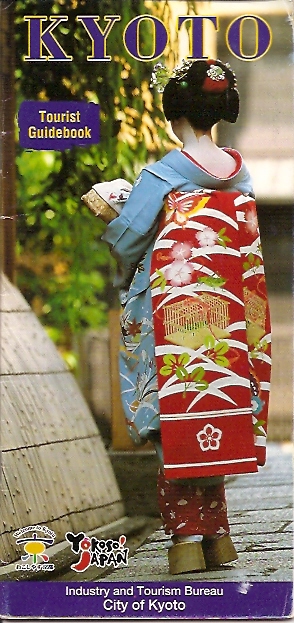Combining colours – blue & red
July 19, 2009
Two photos of geisha kimono – one with a pale blue and red, the other with a darker blue and red – plus some chatter recently on the airwaves among the temari community about choosing colours for temari – have inspired today’s exercise:

…a bright cobalt blue contrasting with a traffic light red, with secondary use of white and gold, plus green. In terms of motifs, the blue seems to contain autumn maple leaves, while the red obi obviously contains butterfly, cricket, cricket cage, etc. Such a strong duality of this red with this blue is not as common as the red/green complimentaries, while the trio of red-white-blue is no stranger to any of us.

Similarly, this KIE magazine issue, hanging around since some previous posts on kanzashi and Kyoto, has a similar use of blue and red, with mediating black and gold (at least from this angle – stricly speaking, the overall effect is pale sky blue with black/gold if we consider just kimono and obi). The use of (obviously) hand-dyed red in the obiage behind the obi is very striking, and obviously imitates the facial makeup. I suspect there is some shibori used in the far right corner of this obiage – shibori always having a close relationship with obiage.
So, with this blue/red color combination in mind, I consulted my ‘bible’ in matters to do with Japanese colour combinations:

… in Hideaki Chijiiwa’s Color harmony, I find it is a combination used in traditional Japanese textiles. This is not surprising, when we consider the use of blue from ai indigo (pale colours indicating not many dips into the dye) and red from the traditional dye-source, benibana, known for its fugitive behaviour.
So, I set about using these colours in a temari of intermediate grade difficulty I’ve been meaning to make for some time. It’s in Ozaki’s Elegant Temari (ISBN 4837706959) and is done in red and white on a black mari: page 26, bottom pattern. I wrapped a sky blue mari and put in a simple 8 division in gold metallic thread. Followed by two overlapping squares 3cm from the poles. At this point, I need to say that the ball was exactly 23cm as per the pattern: interestingly, the pattern didn’t call for direct geometric divisions, e.g. a half, or a third of any set distance, but prescribed distances in centimetres. So in these cases, I follow the pattern and work out any ways of enlarging the pattern for larger balls later on.
Now the order of stitching is not exactly clear from the pattern, so with some experimentation and ripping out stitching as I went, I ended up doing a set of four ‘kite’ patterns and then doing the next four interlocking over and under the first (that is, do those labelled A then those labelled B). My first mistake was not to interlock the kites, so I had one lot completely overlapping the other… doh! During the ripping out process, I changed my colours from bright white and traffic-light red, to a darker crimson and a two shades of blue. This immediately made the whole thing a lot more tranquil – I have to say the red/white/black of the original has been putting me off for ages with its over-the-top striking quality! – but inevitably the crimson moves towards the blue becoming somewhat purple at a distance.
Unfortunately with a ball as small as 23cm circumference, every measurement counts, so tolerances for errors have to be extremely small. This is also a good exercise in keeping stitches parallel to jiwari guidelines, because they have to meet up at the ‘seams’ of the guidelines. Ultimately, I veered from my original intention somewhat in not having so strong a white contrast.
Picture to follow!